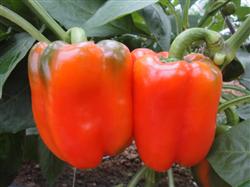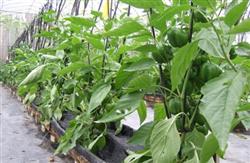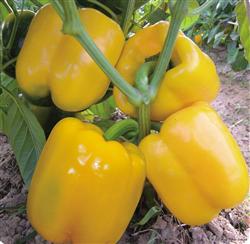How to grow colored sweet peppers?

How to grow colored sweet peppers? Please give guidance for the cultivation of colored sweet pepper can refer to the following methods: (1) the main stubble arrangement 1, annual cultivation in self-controlled heating greenhouse and winter and spring cultivation in northern solar greenhouse, generally sowing seedlings in mid-August and planting in mid-October, the harvest period can last from mid-January to July. This stubble is called long-term cultivation model, which is characterized by long harvest time, high yield and good economic benefits, but the corresponding requirements for water and fertilizer management and heat preservation measures are also high. 2. When cultivated in the plastic greenhouse in the south in early spring, the seedlings are usually sowed in late October (under the condition of electric hotbed), and large seedlings are planted at the beginning of March of the following year, and the harvest period is from April to July. If the condition of raising seedlings is poor, the sowing date will be postponed. On the other hand, autumn stubble can be sowed in early July, planted in mid-late August, and heat preservation will be strengthened in the later period, which is concentrated in New Year's Day-Spring Festival period. The harvest time of this stubble is short, but the market price is high. 3. Due to the influence of high temperature in summer, the above models can not produce products from August to November, but in alpine areas with an altitude of about 600 meters above sea level, sowing and raising seedlings in early spring, using the characteristics of low summer temperature for summer cultivation, can make up for this deficiency. (2) the seedling technology of sowing and seedling raising of colored sweet pepper is very important to obtain high yield. in principle, attention should be paid to cooling and shading in summer and heat preservation in winter (but the humidity should not be too high). The best seedling temperature is 26 degrees in the day and 19 degrees at night. The seedling emergence of colored sweet pepper is slow, the seedling period is long, and too much moisture in the seedling bed can easily lead to rotten seeds, so it is best to use soilless substrate to shade seedlings in summer, seedlings should be raised in a nutrition bowl with 2 leaves and 1 heart, and generally planted at 4 times with 5 true leaves. (3) planting and fertilization irrigation 1. Under the long-period cultivation mode, the planting density is 3 plants per square meter, the plant spacing is 40 cm and the row spacing is 80 cm. If the cultivation period is short, the density can be increased to 5 plants per square meter, so as to increase the early yield. 2. The seedlings applied 5000 kg rotten organic fertilizer, topdressing once every half a month or so (15 kg of ternary compound fertilizer). As a result, available phosphorus and potassium fertilizer (potassium dihydrogen phosphate, etc.) should be added in the peak period. 3. Regular quantitative irrigation is very important for the normal growth of the plant, and the soil moisture during the growing period should be stable; too dry and too wet will lead to abnormal fruit. 4. The best temperature in the growing period is 25Mui 27 degrees in the daytime and 16Mui 18 degrees at night. The lowest soil temperature is kept above 18 degrees. (4) pruning method and plant management color sweet pepper needs pruning, the specific way is: each plant only leaves 2 main branches, while the other side branches are topped after leaving 1-2 leaves. The cultivation density depends on the number of branches per unit area, which is generally 5-7 branches per hectare. There are more branches in the environment with strong light or in the greenhouse with high light transmittance, otherwise there are few, in principle, go to the door pepper. In actual production, the position of remaining pepper should be determined according to plant growth, nutritional status and climatic conditions. It is appropriate to set 3 fruits per branch for the first time. Too much fruit setting in the early stage will lead to little or no fruit setting in the following period of time, which shows a sharp fluctuation in production. The malformed fruit should be removed in time, but the fruit with navel rot should not be removed prematurely so as not to affect the growth balance of the plant. When the plant height is 50 cm, the main branch is hoisted by rope, and the plant height can eventually reach more than 2 meters. The pruning of sweet peppers should not be done too frequently, 2-3 Monday. Compared with other crops, sweet pepper is more sensitive to extreme temperature and humidity, so it is very important to make rational use of protected facilities to create a good and stable growth environment for plants. Pest control: pay attention to the prevention and control of early blight in spring and autumn, gray mold in winter, tea mites and whitefly in spring and summer. (5) the management of color conversion varieties 1. Among the five varieties, yellow, orange and red pepper has a color conversion period. after the fruit is enlarged and formed, proper control of water to increase light and increase the temperature difference between day and night are beneficial to speed up the color conversion speed, when the color conversion rate is 32 degrees during the day and 14 degrees at night. 16 degrees is the most favorable for color conversion. 2. When yellow-orange-red pepper is harvested as green pepper, it should be harvested in time after the fruit is set. 3. Compared with yellow, orange and red pepper, purple pepper and white pepper has smaller fruit and lighter fruit weight, but it is easier to cultivate because there is no color conversion period. 4. When five varieties are needed to enter the peak fruiting period and go on the market at the same time, the yellow-orange-red pepper should be sowed and raised seedlings about 30 days earlier than the purple and white pepper. (6) the number of times of fruit harvest of colored pepper mainly depends on the length of the suitable growth period. Under general conditions, it should be harvested once every three days, and it is appropriate to harvest in the morning. In order to maintain longer shelf life, postharvest fruits should be protected from high temperature and sunlight. Click to get more sweet pepper planting techniques click to get more vegetable planting techniques
- Prev

What are the ways to promote the color conversion of sweet pepper?
What are the ways to promote the color conversion of sweet pepper? Please give guidance to promote the color conversion of sweet pepper in the following four ways: first, through topdressing, supplement potash and boron fertilizer, do not use too much nitrogen fertilizer. Usually, the amount of potash fertilizer is about 1.5 times that of nitrogen fertilizer. In order to promote the color change of sweet pepper, good color. Second, improve the lighting conditions to avoid the lack of light.
- Next

How to plant colored sweet peppers in spring?
How to plant colored sweet peppers in spring? If there are any points to pay attention to, please refer to the following methods for planting colored sweet peppers in spring: variety selection and seedling raising: colored sweet peppers should choose varieties with strong disease resistance, easy cultivation and high yield, such as our company's Manqi and Kagino. Sowing seeds in hotbeds or in winter-warm greenhouses.
Related
- Where is it suitable to grow horseradish in China? it is expected to see the middle altitude horseradish in Alishan.
- How to prevent tomato virus disease reasonably? (Control methods included)
- Many people like to plant towel gourd on the balcony. What are the main points of this method and management?
- What crops can chili peppers be mixed with?
- Fertilization techniques and matters needing attention in Tomato
- What are the grafting techniques for peach seedlings in spring?
- Harm and control methods of root swelling disease of Chinese cabbage
- What are the pests of sweet potatoes? How to prevent and cure it?
- Symptoms, causes and Control methods of navel Rot in Tomato
- The cause of "Cucumber rotten bibcock" in Farmers' planting Cucumber and its Control Plan

